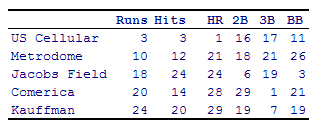Jay Jaffe at Futility Infielder has compiled and published Defense Independent Pitching stats for 2004. As I always do when I see fresh stats, I scroll to find out if there is anything interesting to be learned about Tiger players. Fortunately for Tiger fans, there is some good news in here. But first, a little DiPS background.
For those that haven’t heard about Defense Independent Pitching it is an idea promoted/discovered by Voros McCracken. The theory is that pitchers do not differ significantly in their ability to prevent hits on balls in play. DiPS is a way of looking at the things that a pitcher can control without the help of defense (strikeouts, walks, homers, hit batsmen) and combining it with league averages for balls in play to see what a pitcher’s stats would look like with typical “luck” and a typical defense behind him. It is also adjusted for park effects. The resulting calculated ERA (noted as DiPS or FIP, or dERA) has been shown to correlate better with the subsequent season’s ERA, than using the traditional ERA. This is just a very quick explanation. For more detail be sure to read Jaffe’s article that accompanies the stats.
As for how this applies to the Tigers, the following table has the defense independent stats for the Tigers’ starters last year. Defense independent ERA is dERA. Earned runs above replacement is a measure of how many runs better than a replacement level pitcher the pitcher was last year. The d-E column is a measure of how the DiPS stats compare to the actual ERA. A negative number indicates that the pitcher was hurt by some combination of bad luck or bad defense.
Most surprising on this list is Jason Johnson, who was widely regarded as the Tigers’ weakest starter last year (despite a handful of very impressive performances). Johnson was among the league leaders in misfortune last year with an actual ERA three quarters of a run higher than his dERA. With a league average dERA of 4.63, it actually makes Johnson an above average pitcher. One pitcher who had even more bad luck was Derek Lowe who’s dERA was a full run lower than his actual ERA. His dERA of 4.40 is almost identical to Johnson’s. Fortunately, it will cost us $4 million for one more year for Johnson’s services as opposed to $36 million over 4 years for Lowe’s.
Jeremy Bonderman’s dERA of 4.37 is a big improvement over last year’s 4.81. At the age of 22 it is another indication that this guy maybe on the road to stardom.
Mike Maroth’s dERA is .44 worse than his actual ERA. However, he still showed great improvement last year as his 2003 dERA was 5.54.
By dERA Nate Robertson was a slightly below average pitcher last year. It was only his first full year in the rotation however. He struckout plenty of guys, but was hurt by home runs and some fatigue down the stretch.
So the good news is that while the Tigers didn’t have a dominant starter last year, the guys 1-4 were all average to above average. Also, all the Tigers starters showed improvement over the previous year. The bad news is that the Tigers pitching staff was victimized by poor defense. In looking at dER’s and actual ER’s there is a gap of 30 runs. Unfortunately the Tigers weren’t able to significantly bolster their defense this offseason.

